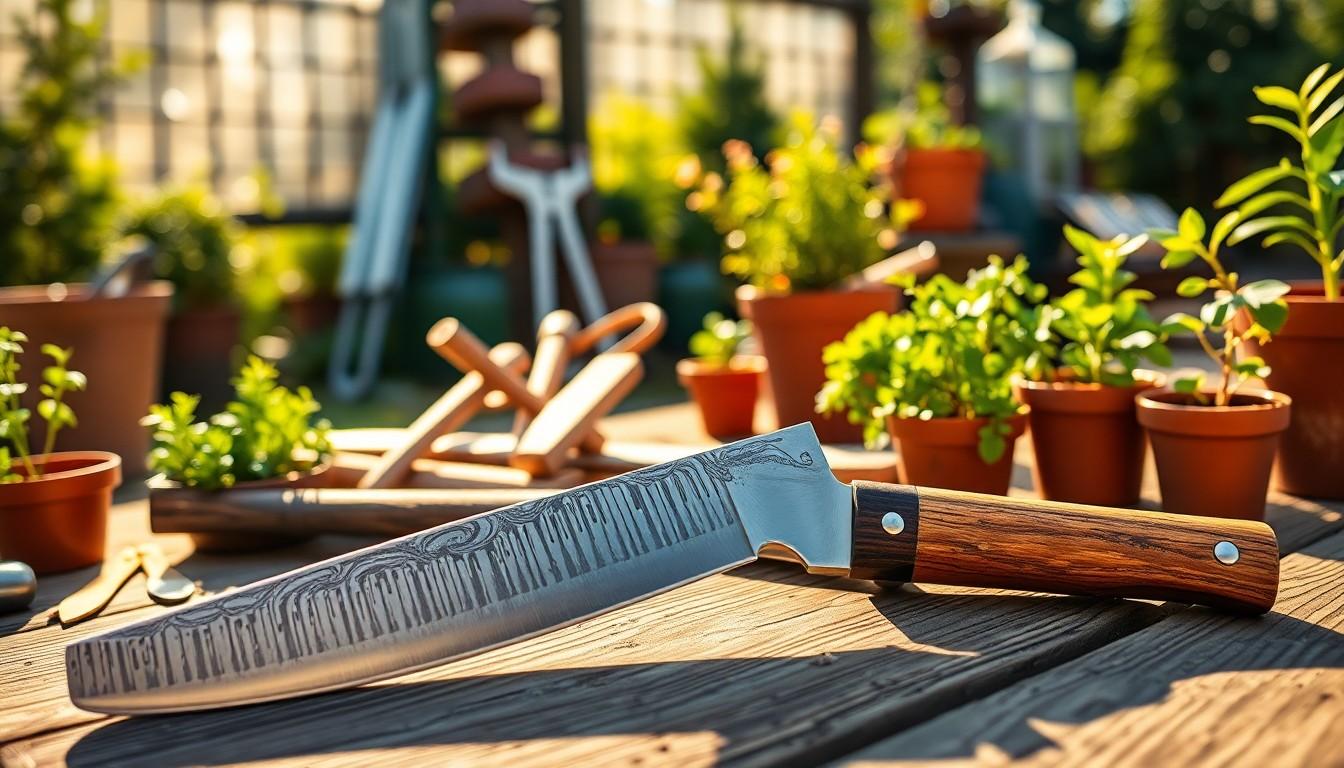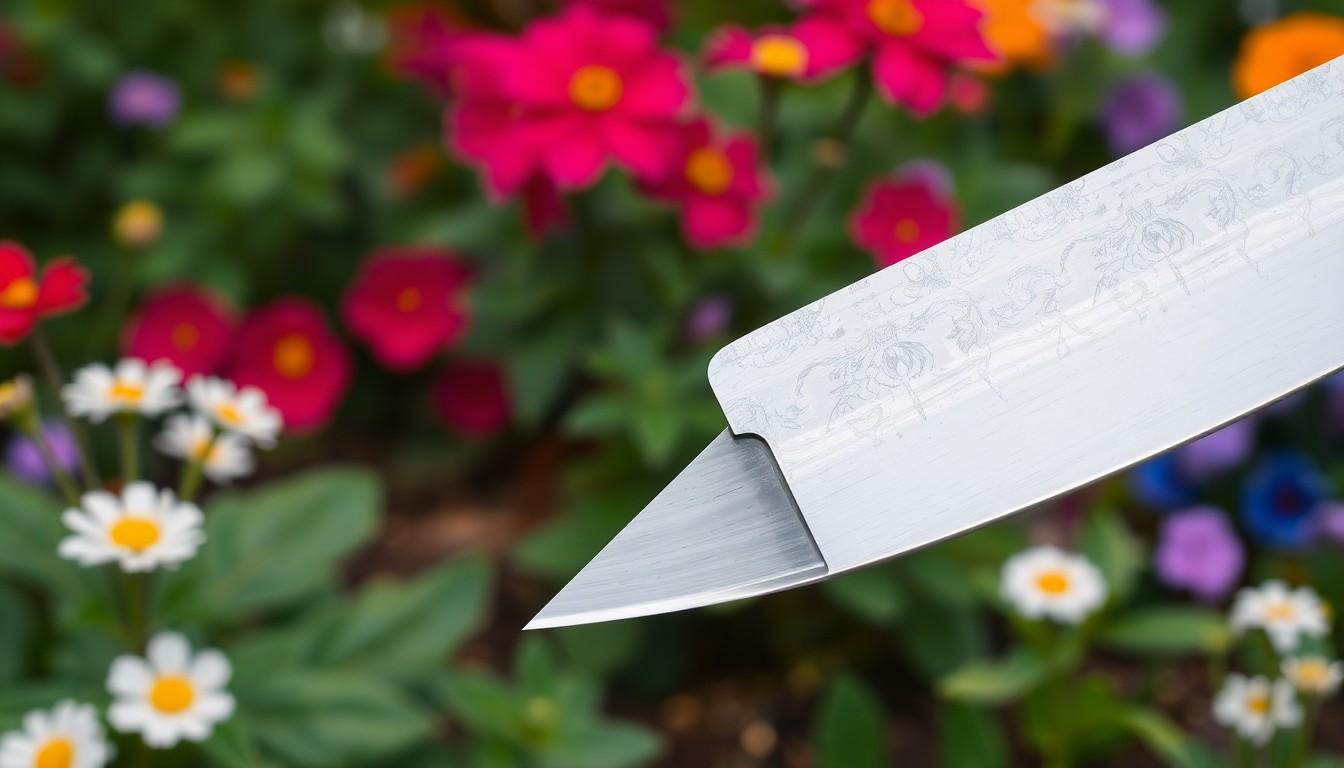Physical Address
304 North Cardinal St.
Dorchester Center, MA 02124

In the world of gardening, the right tools can make all the difference, and the Japanese gardening knife is a game-changer. This sleek, versatile blade isn’t just a pretty face; it’s the Swiss Army knife of the garden, ready to tackle everything from stubborn weeds to delicate pruning. With a design that’s as sharp as your neighbor’s gossip, it’s no wonder this tool has become a gardener’s best friend.
Imagine effortlessly slicing through roots and branches while channeling your inner samurai. Whether you’re a seasoned pro or a weekend warrior, this knife will elevate your gardening game. Say goodbye to flimsy tools and hello to precision and style. Ready to dig into the details? Let’s explore why this little wonder deserves a spot in every gardener’s toolkit.
Japanese gardening knives, known for their precision and craftsmanship, are integral tools for both professional and amateur gardeners. These knives serve multiple purposes, making them invaluable in various gardening tasks. They excel at weeding, pruning, and harvesting, ensuring efficiency in any gardening endeavor.
The design of a Japanese gardening knife features a sharp, curved blade that allows for clean cuts. This blade shape minimizes damage to surrounding plants, essential for maintaining garden health. Materials used in the blade construction often include high-carbon steel, which provides durability and retains sharpness over time.
Handles of these knives typically feature ergonomic designs, promoting comfort during prolonged use. Many models incorporate traditional wooden handles for balance and aesthetic appeal. Users appreciate how well these handles fit into their hands, reducing fatigue while working.
Maintenance of a Japanese gardening knife involves regular cleaning and occasional sharpening. Proper care extends the life of the knife, preserving its cutting efficiency. Gardeners find that investing time in maintenance significantly enhances their tool’s performance.
Available in various sizes, the Japanese gardening knife caters to different gardening styles and tasks. Smaller blades are ideal for intricate work, while larger options can tackle tougher jobs. Choices available in the market often reflect the specific needs of the user.
Understanding the versatility and efficiency of Japanese gardening knives promotes their adoption among gardeners. With their ability to effectively handle diverse tasks, they represent a worthwhile investment in any gardening toolkit.

Japanese gardening knives possess distinctive features that set them apart. These characteristics enhance their utility, making them indispensable tools for gardeners.
High-carbon steel serves as the primary material for Japanese gardening knife blades. This composition ensures durability and resistance to wear. Sharpness remains intact even after rigorous use. Various quality levels of high-carbon steel exist, impacting performance and longevity. Blades, often handmade, reflect exceptional craftsmanship. They can penetrate tough materials, facilitating tasks such as weeding or pruning. Many blades showcase a curved design, promoting clean cuts that minimize damage to surrounding plants. Overall, the blade material contributes significantly to the knife’s effectiveness and reliability.
Ergonomic handle designs enhance comfort during extended gardening sessions. Often made from traditional wood, these handles provide a natural grip. High-quality materials ensure that handles withstand environmental conditions over time. Some designs incorporate contoured shapes, fitting the hand better and reducing fatigue. Various sizes of handles cater to different user preferences and hand sizes. Additional finishes may offer a more tactile feel, improving handling. This thoughtful design contributes to an overall enjoyable gardening experience.
Japanese gardening knives offer numerous advantages for those who engage in gardening activities. Their design promotes efficiency, precision, and ease of use, elevating the gardening experience.
Precision defines the utility of a Japanese gardening knife. The sharp, curved blade facilitates clean cuts, reducing damage to surrounding plants. Gardeners experience improved control, allowing for intricate tasks like trimming delicate stems and shaping bonsai. With an ergonomic handle, users can handle the knife comfortably, leading to steadier movements. A blend of design and craftsmanship enhances overall accuracy, making it an ideal tool for detailed gardening work.
Versatility shines through the capabilities of a Japanese gardening knife. Gardeners can employ it for diverse tasks, including weeding, pruning, and harvesting. One tool addresses multiple challenges, from cutting through tough roots to delicate snipping of flowers. Different sizes and designs cater to various gardening styles, whether managing a large vegetable patch or tending to ornamental plants. Its adaptability ensures effective results across a range of gardening activities, making it a multifunctional asset in any gardener’s toolkit.
Japanese gardening knives come in various types, each designed for specific tasks. Understanding these popular options helps gardeners select the right tool for their needs.
The Hori Hori knife features a pointed, serrated blade that excels at digging and cutting. Gardeners often use it for weeding and planting. Versatility defines this tool; it can slice through roots or break up soil with ease. The knife’s sharp edge makes it effective for harvesting and dividing perennial plants too. Traditional designs often include a wooden handle that adds comfort during prolonged use. With its robust construction, the Hori Hori knife maintains sharpness, promoting longevity.
The Kiwami knife stands out for its elegant design and precision. Often used for bonsai trimming, this knife enables intricate cuts with minimal effort. The blade’s curvature allows for smooth, clean actions while shaping delicate plants. Made from high-carbon steel, the Kiwami knife is durable and retains its sharpness. Additional attention to craftsmanship highlights the quality of each piece. Users appreciate its lightweight feel, which reduces fatigue during extended gardening sessions. Versatile in nature, it adapts for various gardening tasks beyond bonsai, making it a valuable addition to any toolkit.
Regular maintenance ensures Japanese gardening knives remain effective and durable. Cleaning these tools after each use keeps the blade free from debris and plant residues. Use warm soapy water and a soft cloth to wipe down the blade, avoiding abrasive materials that may scratch the surface.
Sharpening the blade contributes significantly to maintaining performance. Occasional sharpening with a whetstone or honing rod helps retain the edge, making cutting tasks easier. Focus on maintaining the original bevel angle for consistent results.
Storage also plays a crucial role in preserving knife quality. Store knives in a dry environment to prevent rust. A knife sheath or a magnetic strip provides a safe way to keep tools organized and protected from damage.
Inspecting the handle for wear and tear ensures comfort during use. Wooden handles may require occasional oiling with a food-safe mineral oil to maintain their integrity and prevent cracking.
Replacing worn components enhances functionality, especially for knives with removable parts like sheaths. Keeping track of any damage allows for prompt repairs, avoiding further issues.
Using these maintenance tips, gardeners can maximize the lifespan and effectiveness of Japanese gardening knives. Proper care reflects dedication to quality tools, reinforcing the excellence of their gardening experience.
The Japanese gardening knife stands out as an indispensable tool for anyone passionate about gardening. Its unique design and craftsmanship offer a blend of efficiency and precision that enhances the gardening experience. With its ability to tackle a variety of tasks from weeding to pruning it’s no wonder that both novice and seasoned gardeners appreciate its value.
Investing in a high-quality Japanese gardening knife not only elevates gardening practices but also ensures longevity with proper maintenance. By integrating this versatile tool into their toolkit gardeners can enjoy improved control and comfort while tending to their plants. Embracing the artistry and functionality of Japanese gardening knives can truly transform the way one interacts with their garden.